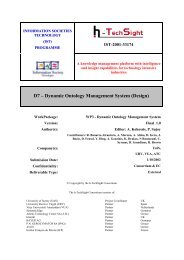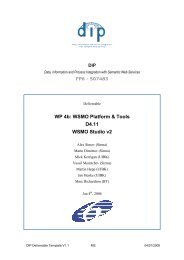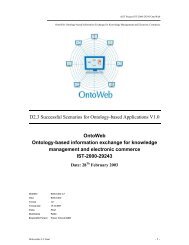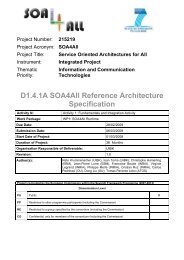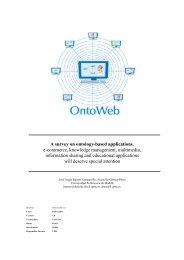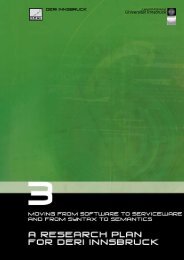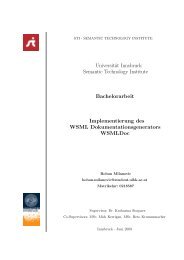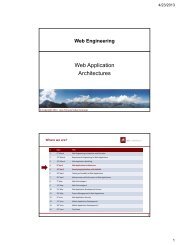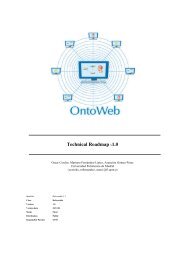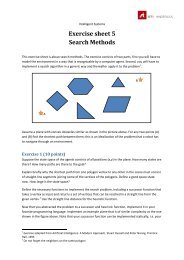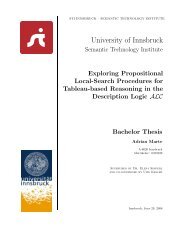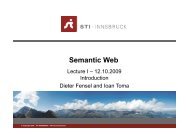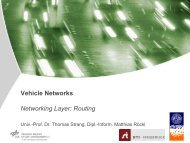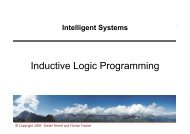Ontology Engineering - STI Innsbruck
Ontology Engineering - STI Innsbruck
Ontology Engineering - STI Innsbruck
Create successful ePaper yourself
Turn your PDF publications into a flip-book with our unique Google optimized e-Paper software.
<strong>Ontology</strong> <strong>Engineering</strong><br />
Next Web Generation 2007<br />
Summer Semester<br />
Slides are taken from UPM<br />
(see below)<br />
©Asunción Gómez-Pérez, M. Fernández-López, O. Corcho 1<br />
Table of Content<br />
1. The role of Ontologies in the semantic web<br />
2. Theoretical Foundations of Ontologies<br />
3. The most Outstanding Ontologies<br />
4. Methodologies and Methods for building Ontologies<br />
5. Languages for Building Ontologies<br />
6. <strong>Ontology</strong> Tools<br />
7. <strong>Ontology</strong>-based Applications<br />
©Asunción Gómez-Pérez, M. Fernández-López, O. Corcho 3<br />
©Asunción Gómez-Pérez, M. Fernández-López, O. Corcho 2<br />
Ontological <strong>Engineering</strong><br />
Asunción Gómez-Pérez<br />
Mariano Fernández-López<br />
Oscar Corcho<br />
{asun, mfernandez, ocorcho}@fi.upm.es<br />
Grupo de Ontologías<br />
Laboratorio de Inteligencia Artificial<br />
Facultad de Informática<br />
Universidad Politécnica de Madrid<br />
Campus de Montegancedo sn,<br />
28660 Boadilla del Monte, Madrid, Spain<br />
Theoretical foundations of ontologies<br />
Asunción Gómez-Pérez<br />
Mariano Fernández-López<br />
Oscar Corcho<br />
{asun, mfernandez, ocorcho}@fi.upm.es<br />
Grupo de Ontologías<br />
Laboratorio de Inteligencia Artificial<br />
Facultad de Informática<br />
Universidad Politécnica de Madrid<br />
Campus de Montegancedo sn,<br />
28660 Boadilla del Monte, Madrid, Spain<br />
©Asunción Gómez-Pérez, M. Fernández-López, O. Corcho 4
Main References<br />
Gómez-Pérez, A.; Fernández-López, M.; Corcho, O. Ontological <strong>Engineering</strong>. Springer Verlag. 2003<br />
http://www.ontoweb.org<br />
Deliverables<br />
•D1.1<br />
•D1.2<br />
•D1.3<br />
•D1.4<br />
•D1.5<br />
Neches, R.; Fikes, R.; Finin, T.; Gruber, T.; Patil, R.; Senator, T.; Swartout, W.R. Enabling Technology for Knowledge Sharing.<br />
AI Magazine. Winter 1991. 36-56.<br />
Gruber, T. A translation Approach to portable ontology specifications. Knowledge Acquisition. Vol. 5. 1993. 199-220.<br />
Uschold, M.; Grüninger, M. ONTOLOGIES: Principles, Methods and Applications. Knowledge <strong>Engineering</strong> Review. Vol. 11; N. 2; June 1996.<br />
©Asunción Gómez-Pérez, M. Fernández-López, O. Corcho 5<br />
Reuse means to build new applications<br />
assembling components already built<br />
Advantages:<br />
• Less money<br />
• Less time<br />
• Less resources<br />
Reuse and Sharing<br />
Areas:<br />
©Asunción Gómez-Pérez, M. Fernández-López, O. Corcho 7<br />
Sharing is when different<br />
applications use the some resources<br />
• Software<br />
• Knowledge<br />
• Communications<br />
• Interfaces<br />
•---<br />
Outline<br />
©Asunción Gómez-Pérez, M. Fernández-López, O. Corcho 6<br />
©Asunción Gómez-Pérez, M. Fernández-López, O. Corcho 8<br />
The Knowledge Sharing Initiative<br />
Definitions of Ontologies<br />
Modeling of Ontologies<br />
Types of Ontologies<br />
Libraries of Ontologies<br />
Ontological Commitments<br />
The knowledge Sharing Initiative<br />
“Building new Knowledge Based Systems today usually entails constructing new<br />
knowledge bases from scratch. It could instead be done by assembling reusable components.<br />
System developers would then only need to worry about creating the specialized knowledge and<br />
reasoners new to the specific task of their systems. This new system would interoperate with<br />
existing systems, using them to perform some of its reasoning. In this way,<br />
declarative knowledge, problem-solving techniques, and reasoning services could all<br />
be shared between systems. This approach would facilitate building bigger and better systems<br />
cheaply. The infraestructure to support such sharing and reuse would lead to greater<br />
ubiquity of these systems, potentially transforming the knowledge industry ...”<br />
Neches, R.; Fikes, R.; Finin, T.; Gruber, T.; Patil, R.; Senator, T.; Swartout, W.R. Enabling Technology for Knowledge Sharing.<br />
AI Magazine. Winter 1991. 36-56.
Reusable Knowledge Components<br />
Ontologies<br />
Describe domain knowledge in a generic way<br />
and provide agreed understanding of a domain<br />
©Asunción Gómez-Pérez, M. Fernández-López, O. Corcho 9<br />
Problem Solving Methods<br />
Describe the reasoning process of a KBS in<br />
an implementation and domain-independent manner<br />
Interaction Problem<br />
Representing Knowledge for the purpose of solving some problem<br />
is strongly affected by the nature of the problem<br />
and the inference strategy to be applied to the problem [Bylander et al., 88<br />
Bylander Chandrasekaran, B. Generic Tasks in knowledge-based reasoning.: the right level of abstraction for knowledge acquisition.<br />
In B.R. Gaines and J. H. Boose, EDs Knowledge Acquisition for Knowledge Based systems, 65-77, London: Academic Press 1988.<br />
Definitions of Ontologies (I)<br />
1. “An ontology defines the basic terms and relations comprising the vocabulary of<br />
a topic area, as well as the rules for combining terms and relations to define<br />
extensions to the vocabulary”<br />
Neches, R.; Fikes, R.; Finin, T.; Gruber, T.; Patil, R.; Senator, T.; Swartout, W.R. Enabling Technology for Knowledge Sharing.<br />
AI Magazine. Winter 1991. 36-56.<br />
2. “An ontology is an explicit specification of a conceptualization”<br />
Gruber, T. A translation Approach to portable ontology specifications. Knowledge Acquisition. Vol. 5. 1993. 199-220.<br />
©Asunción Gómez-Pérez, M. Fernández-López, O. Corcho 11<br />
Outline<br />
©Asunción Gómez-Pérez, M. Fernández-López, O. Corcho 10<br />
©Asunción Gómez-Pérez, M. Fernández-López, O. Corcho 12<br />
The Knowledge Sharing Initiative<br />
Definitions of Ontologies<br />
Modeling of Ontologies<br />
Types of Ontologies<br />
Libraries of Ontologies<br />
Ontological Commitments<br />
Definitions of Ontologies (II)<br />
3. An ontology is a hierarchically structured set of terms for describing a domain<br />
that can be used as a skeletal foundation fora knowledgebase.<br />
B. Swartout; R. Patil; k. Knight; T. Russ. Toward Distributed Use of Large-Scale Ontologies<br />
Ontological <strong>Engineering</strong>. AAAI-97 Spring Symposium Series. 1997. 138-148.<br />
4. An ontology provides the means for describing explicitly the conceptualization<br />
behind the knowledge represented in a knowledge base.<br />
A. Bernaras;I. Laresgoiti; J. Correra. Building and Reusing Ontologies for Electrical Network Applications<br />
ECAI96. 12th European conference on Artificial Intelligence. Ed. John Wiley & Sons, Ltd. 298-302.
Definitions of Ontologies (III)<br />
5. “An ontology is a formal, explicit specification of a shared conceptualization”<br />
Machine-readable<br />
Concepts, properties<br />
relations, functions,<br />
constraints, axioms,<br />
are explicitly defined<br />
Studer, Benjamins, Fensel. Knowledge <strong>Engineering</strong>: Principles and Methods. Data and Knowledge <strong>Engineering</strong>. 25 (1998) 161-197<br />
©Asunción Gómez-Pérez, M. Fernández-López, O. Corcho 13<br />
Lightweight Ontologies :<br />
Consensual<br />
Knowledge<br />
Definitions of Ontologies (II)<br />
•Include Concepts with properties and Taxonomies<br />
•Do not include Axioms and constraints.<br />
Heavyweight Ontologies :<br />
•Include all the components<br />
• Excellent!! If they have a lot of axioms.<br />
©Asunción Gómez-Pérez, M. Fernández-López, O. Corcho 15<br />
Abstract model and<br />
simplified view of some<br />
phenomenon in the world<br />
that we want to represent<br />
Definitions of Ontologies (I)<br />
1. “An ontology defines the basic terms and relations comprising the<br />
vocabulary of a topic area, as well as the rules for combining terms and<br />
relations to define extensions to the vocabulary”<br />
2. “An ontology is an explicit specification of a conceptualization”<br />
3. “An ontology is a formal, explicit specification of a shared<br />
conceptualization”<br />
4. “A logical theory which gives on explicit, partial account of a<br />
conceptualization”<br />
5. “A set of logical axioms designed to account for the intended<br />
meaning of a vocabulary”<br />
©Asunción Gómez-Pérez, M. Fernández-López, O. Corcho 14<br />
Outline<br />
©Asunción Gómez-Pérez, M. Fernández-López, O. Corcho 16<br />
The Knowledge Sharing Initiative<br />
Definitions of Ontologies<br />
Modeling of Ontologies<br />
•Components<br />
•Principles<br />
•Approaches<br />
Types of Ontologies<br />
Libraries of Ontologies<br />
Ontological Commitments<br />
Neches R, Fikes RE, Finin T, Gruber TR, Senator T, Swartout WR<br />
(1991) Enabling technology for knowledge sharing. AI Magazine<br />
12(3):36–56<br />
Gruber TR (1993a) A translation approach to portable<br />
ontology specification. Knowledge Acquisition<br />
5(2):199–220<br />
Studer R, Benjamins VR, Fensel D (1998) Knowledge <strong>Engineering</strong>:<br />
Principles and Methods.<br />
IEEE Transactions on Data and Knowledge <strong>Engineering</strong> 25(1-<br />
2):161–197<br />
Guarino N, Giaretta P (1995) Ontologies and Knowledge Bases:<br />
Towards a Terminological Clarification. In: Mars N (ed)<br />
Towards Very Large Knowledge Bases: Knowledge Building<br />
and Knowledge Sharing (KBKS’95). University of Twente,<br />
Enschede, The Netherlands. IOS Press, Amsterdam, The<br />
Netherlands, pp 25–32<br />
Guarino N (1998) Formal <strong>Ontology</strong> in Information Systems. In:<br />
Guarino N (ed) 1st International Conference on<br />
Formal <strong>Ontology</strong> in Information Systems (FOIS’98). Trento,<br />
Italy. IOS Press, Amsterdam, pp 3–15
Components of an <strong>Ontology</strong><br />
Concepts are organized in taxonomies<br />
Relations<br />
Functions<br />
Instances<br />
Axioms<br />
R: C1 x C2 x ... x Cn-1 x Cn<br />
F: C1 x C2 x ... x Cn-1 --> Cn<br />
Elements<br />
Sentences which are always true<br />
©Asunción Gómez-Pérez, M. Fernández-López, O. Corcho 17<br />
Subclass-Of<br />
Superclass-Of<br />
Person Dog Cat<br />
Subclass-Of<br />
Instance-Of<br />
Mammal<br />
Subclass-Of<br />
Cartoon Dog<br />
©Asunción Gómez-Pérez, M. Fernández-López, O. Corcho 19<br />
Subclass-of: Concept 1 x Concept2<br />
Connected to: Component1 x Component2<br />
Mother-of: Person --> Women<br />
Price of a used car: Model x Year x Kilometers --> Price<br />
How to build taxonomies (II)<br />
Subclass-Of<br />
Pluto<br />
Instance-Of<br />
Gruber, T. A translation Approach to portable<br />
ontology specifications. Knowledge Acquisition.<br />
Vol. 5. 1993. 199-220.<br />
A. Gómez-Pérez. Evaluation of Ontologies.<br />
International Journal of Intelligent Systems.<br />
Vol. 16, Nº3. March 2001. PP391-410<br />
Pluto could be an instance of cat and dog<br />
Semantic Error<br />
Partition and Disjoint<br />
class-Partition: a partition of class C is a set of subclasses of C that does not share common<br />
Instances but that covers C. � there are not instances of C that are not instances of one of the<br />
concepts in the partition.<br />
Example: the concept „InternationalFlight“ and „DomesticFlight“ make up a<br />
partition of the concept „Flight“ because every flight is either international or domestic<br />
Disjoint: a disjoint of a concept C is a set of subclasses of C that do not have common<br />
instances and do not cover C. � there can be instances of the concept C that are not instances<br />
of any of the concepts in the decomposition<br />
For example: the concept „BA0068, BA0066, BA0069“ make up a disjoint decomposition of<br />
the concept „BrithishAirwaysFlight“<br />
Exhaustive-Disjoint: a an exhaustive-disjoint of a concept C is a set of subclasses of C that<br />
cover C and may have common instances and subclasses. �there cannot be instances of the<br />
concept C that are not instances of at least one of the concepts in the decomposition.<br />
For example: the concept „EconomyTrip, BussinessTrip, LuxuryTrip“ make up an exhaustive<br />
decomposition of the concept „TravelPackage“. A business trip can be economic or luxury trip.<br />
©Asunción Gómez-Pérez, M. Fernández-López, O. Corcho 18<br />
Disjoint<br />
Person Dog Cat<br />
Subclass-Of<br />
Cartoon Dog<br />
Instance-Of<br />
How to build taxonomies (III)<br />
Mammal<br />
Subclass-Partition<br />
Instance-Of Has-Instance<br />
Pluto<br />
©Asunción Gómez-Pérez, M. Fernández-López, O. Corcho 20<br />
A. Gómez-Pérez. Evaluation of Ontologies.<br />
International Journal of Intelligent Systems.<br />
Vol. 16, Nº3. March 2001. PP391-410<br />
Pluto can not be simultaneously a class of Cat and<br />
Dog because they are disjoint
Disjoint<br />
Subclass-Partition<br />
Number<br />
Even Odd<br />
How to build taxonomies (IV)<br />
Instance-Of<br />
©Asunción Gómez-Pérez, M. Fernández-López, O. Corcho 21<br />
4<br />
Four is an instance of Partition<br />
A. Gómez-Pérez. Evaluation of Ontologies.International Journal of Intelligent Systems. Vol. 16, Nº3. March 2001. PP391-410<br />
Example of Domain <strong>Ontology</strong><br />
©Asunción Gómez-Pérez, M. Fernández-López, O. Corcho 23<br />
How to build taxonomies (V)<br />
Exhaustive-Disjoint<br />
Subclass-Partition<br />
Number<br />
Odd Even<br />
©Asunción Gómez-Pérez, M. Fernández-López, O. Corcho 22<br />
©Asunción Gómez-Pérez, M. Fernández-López, O. Corcho 24<br />
Instance-Of<br />
4<br />
Four is an instance of something in the partition
Semi-informal:<br />
Semi-formal:<br />
What does an Explicit <strong>Ontology</strong> look Like?<br />
Highly informal:<br />
in natural language<br />
An html ontology for linking documents<br />
Example<br />
Example<br />
Rigorously formal:<br />
Example<br />
©Asunción Gómez-Pérez, M. Fernández-López, O. Corcho 25<br />
in a restricted and structured form of natural language<br />
in an artificial and formally defined language<br />
in a language with formal semantics, theorems and proofs<br />
of such properties as soundness and completeness<br />
Uschold, M.; Grüninger, M. ONTOLOGIES: Principles, Methods and Applications.<br />
Knowledge <strong>Engineering</strong> Review. Vol. 11; N. 2; June 1996.<br />
Clarity<br />
An ontology should communicate effectively the intended meaning of defined terms.<br />
Definitions should be objective. Definitions can be stated on formal axioms, and a complete<br />
definition (defined by necessary and sufficient conditions) is preferred over a partial<br />
definition (defined by only necessary or sufficient conditions). All definitions should be<br />
documented with natural language<br />
(define-class Travel (?travel)<br />
"A journey from place to place"<br />
:axiom-def<br />
(and (Superclass-Of Travel Flight)<br />
(Subclass-Of Travel Thing)<br />
(Template-Facet-Value Cardinality<br />
arrivalDate Travel 1)<br />
(Template-Facet-Value Cardinality<br />
departureDate Travel 1)<br />
(Template-Facet-Value Maximum-Cardinality<br />
No Clarity<br />
singleFare Travel 1))<br />
:def<br />
(and (arrivalDate ?travel Date)<br />
(departureDate ?travel Date)<br />
(singleFare ?travel Number)<br />
(companyName ?travel String)))<br />
©Asunción Gómez-Pérez, M. Fernández-López, O. Corcho 27<br />
Clarity:<br />
Principles for the Design of Ontologies (I)<br />
To communicate the intended meaning of defined terms<br />
Coherence:<br />
To sanction inferences that are consistent with definitions<br />
Extendibility:<br />
To anticipate the use of the shared vocabulary<br />
Minimal Encoding Bias:<br />
To be independent of the symbolic level<br />
Minimal Ontological Commitments:<br />
To make as few claims as possible about the world<br />
©Asunción Gómez-Pérez, M. Fernández-López, O. Corcho 26<br />
Clarity<br />
Clarity<br />
©Asunción Gómez-Pérez, M. Fernández-López, O. Corcho 28<br />
• Gruber, T.; Towards Principles for the Design of Ontologies.<br />
KSL-93-04. Knowledge Systems Laboratory.<br />
Stanford University. 1993<br />
(define-class Travel (?travel)<br />
"A journey from place to place"<br />
:axiom-def<br />
(and (Superclass-Of Travel Flight)<br />
(Subclass-Of Travel Thing)<br />
(Template-Facet-Value Cardinality<br />
arrivalDate Travel 1)<br />
(Template-Facet-Value Cardinality<br />
departureDate Travel 1)<br />
(Template-Facet-Value Maximum-Cardinality<br />
singleFare Travel 1))<br />
:iff-def<br />
(and (arrivalDate ?travel Date)<br />
(departureDate ?travel Date))<br />
:def<br />
(and (singleFare ?travel Number)<br />
(companyName ?travel String)))
Minimal Encoding Bias<br />
“The conceptualization should be specified at the knowledge level<br />
without depending on a particular symbol-level encoding”.<br />
(define-class Travel (?travel)<br />
"A journey from place to place"<br />
:axiom-def<br />
(and (Superclass-Of Travel Flight)<br />
(Subclass-Of Travel Thing)<br />
(Template-Facet-Value Cardinality<br />
arrivalDate Travel 1)<br />
(Template-Facet-Value Cardinality<br />
departureDate Travel 1)<br />
(Template-Facet-Value Maximum-Cardinality<br />
singleFare Travel 1))<br />
:iff-def<br />
(and (arrivalDate ?travel Date)<br />
(departureDate ?travel Date))<br />
:def<br />
No minimal Encoding Bias<br />
(and (singleFare ?travel Number)<br />
(companyName ?travel String)))<br />
©Asunción Gómez-Pérez, M. Fernández-López, O. Corcho 29<br />
Minimal Encoding Bias<br />
(singleFare ?travel Number)<br />
should be substituted by:<br />
(singleFare ?travel CurrencyQuantity)<br />
©Asunción Gómez-Pérez, M. Fernández-López, O. Corcho 31<br />
Standard-Dimensions <strong>Ontology</strong><br />
....<br />
Density-Dimension<br />
....<br />
Instance-of<br />
Frequency-Dimension<br />
....<br />
Length-Dimension<br />
Mass-Dimension<br />
....<br />
Pressure-Dimension<br />
Resistance-Dimension<br />
......<br />
Instance-of<br />
Work-Dimension<br />
Currency Dimension<br />
Minimal Encoding Bias<br />
Physical-Quantities <strong>Ontology</strong><br />
Unit-of-Measure<br />
©Asunción Gómez-Pérez, M. Fernández-López, O. Corcho 30<br />
Subclass-of<br />
Instance-of<br />
Instance-of<br />
System-of-Units Si-Unit<br />
Instance-of<br />
Physical-Dimension<br />
Extensibility<br />
©Asunción Gómez-Pérez, M. Fernández-López, O. Corcho 32<br />
Standard-Units <strong>Ontology</strong><br />
Instance-of<br />
Instance-of<br />
“One should be able to define new terms<br />
for special uses based on the existing vocabulary,<br />
in a way that does not require the revision of the existing definitions”.<br />
• Currency dimension<br />
• Definition of currencies<br />
• Relationship between currencies<br />
Ampere<br />
Amu<br />
Angstrom<br />
.<br />
.<br />
.<br />
Volt<br />
Watt<br />
Year<br />
Euro<br />
Ampere<br />
Candela<br />
Degree-Kelvin<br />
Identity-Unit<br />
Kilogram<br />
Meter<br />
Mole<br />
Second-of-Time<br />
(define-individual Euro (Unit-of-Measure)<br />
"An Euro is the currency on the European Union"<br />
:= (* 0,96 USDollar)<br />
:axiom-def<br />
(= (Quantity.dimension Euro) CurrencyDimension))
Coherence<br />
“An ontology should be coherent: that is, it should sanction inferences<br />
that are consistent with the definitions.[…]<br />
If a sentence that can be inferred from the axioms contradicts a definition<br />
or example given informally, then the ontology is incoherent”.<br />
(define-axiom No-Train-between-USA-and-Europe<br />
"It is not possible to travel by train between the USA and Europe"<br />
:= (forall (?travel)<br />
(forall (?city1)<br />
(forall (?city2)<br />
(=> (and (Travel ?travel)<br />
(arrivalPlace ?travel ?city1)<br />
(departurePlace ?travel ?city2)<br />
(or (and (EuropeanLocation ?city1)<br />
(USALocation ?city2))<br />
(and (EuropeanLocation ?city2)<br />
(USALocation ?city1) )))<br />
(not (TrainTravel ?travel)))))))<br />
(define-instance Madrid (EuropeanLocation))<br />
(define-instance NewYork (USALocation))<br />
©Asunción Gómez-Pérez, M. Fernández-López, O. Corcho 33<br />
Principles for the Design of Ontologies (IV)<br />
• The representation of disjoint and exhaustive knowledge. If the set of<br />
subclasses of a concept are disjoint, we can define a disjoint decomposition.<br />
The decomposition is exhaustive if it defines the superconcept completely.<br />
• To improve the understandability and reusability of the ontology, we should<br />
implement the ontology trying to minimize the syntactic distance between<br />
sibling concepts.<br />
• The standardization of names. To ease the understanding of the ontology<br />
the same naming conventions should be used to name related terms.<br />
Arpírez JC, Gómez-Pérez A, Lozano A, Pinto HS (1998) (ONTO) 2 Agent: An ontology-based WWW broker to select ontologies.<br />
In: Gómez-Pérez A, Benjamins RV (eds) ECAI’98 Workshop on Applications of Ontologies and Problem-Solving Methods.<br />
Brighton, United Kingdom, pp 16–24<br />
©Asunción Gómez-Pérez, M. Fernández-López, O. Corcho 35<br />
Minimal Ontological Commitments<br />
“Since ontological commitment is based on the consistent use of the vocabulary,<br />
ontological commitment can be minimized by specifying the weakest theory<br />
and defining only those terms that are essential to the communication of knowledge<br />
consistent with the theory”.<br />
(define-class Travel (?travel)<br />
"A journey from place to place"<br />
:axiom-def<br />
( .... )<br />
:iff-def<br />
(and (arrivalDate ?travel Date)<br />
(departureDate ?travel Date))<br />
:def<br />
(and (singleFare ?travel Number)<br />
(companyName ?travel String)))<br />
©Asunción Gómez-Pérez, M. Fernández-López, O. Corcho 34<br />
©Asunción Gómez-Pérez, M. Fernández-López, O. Corcho 36<br />
•What is a date?<br />
• Absolute/relative date?<br />
• could be an interval?<br />
• date= month + year<br />
• date= day + month +year<br />
• date = month +day +year<br />
Approaches for Modeling Ontologies<br />
•Using frames and first order logic<br />
•Using description logic<br />
•Using UML<br />
•Using the entity relationship model
Using the Entity Relationship Model for<br />
Modeling Ontologies<br />
©Asunción Gómez-Pérez, M. Fernández-López, O. Corcho 37<br />
Using Frames and First Order Logic for Modeling Ontologies<br />
(define-class Travel (?travel)<br />
"A journey from place to place"<br />
:axiom-def<br />
(and (Superclass-Of Travel Flight)<br />
(Template-Facet-Value Cardinality<br />
arrivalDate Travel 1)<br />
(Template-Facet-Value Cardinality<br />
departureDate Travel 1)<br />
(Template-Facet-Value Maximum-Cardinality<br />
singleFare Travel 1))<br />
:def<br />
(and (arrivalDate ?travel Date)<br />
(departureDate ?travel Date)<br />
(singleFare ?travel Number)<br />
(companyName ?travel String)))<br />
(define-instance AA7462-Feb-08-2002 (AA7462)<br />
:def ((singleFare AA7462-Feb-08-2002 300)<br />
(departureDate AA7462-Feb-08-2002 Feb8-2002)<br />
(arrivalPlace AA7462-Feb-08-2002 Seattle)))<br />
©Asunción Gómez-Pérez, M. Fernández-López, O. Corcho 39<br />
(define-function Pays (?room ?discount) :-> ?finalPrice<br />
"Price of the room after applying the discount"<br />
:def (and (Room ?room) (Number ?discount)<br />
(Number ?finalPrice)<br />
(Price ?room ?price))<br />
:lambda-body<br />
(- ?price (/ (* ?price ?discount) 100)))<br />
(define-relation connects (?edge ?source ?target)<br />
"This relation links a source and a target by an edge.<br />
The source and destination are considered as spatial<br />
points. The relation has the following properties: symmetry<br />
and irreflexivity."<br />
:def (and (SpatialPoint ?source)<br />
(SpatialPoint ?target)<br />
(Edge ?edge))<br />
:axiom-def<br />
((=> (connects ?edge ?source ?target)<br />
(connects ?edge ?target ?source)) ;symmetry<br />
(=> (connects ?edge ?source ?target)<br />
(not (or (part-of ?source ?target) ;irreflexivity<br />
(part-of ?target ?source))))))<br />
Using UML for Modeling Ontologies<br />
©Asunción Gómez-Pérez, M. Fernández-López, O. Corcho 38<br />
Using Description Logics for Modeling Ontologies<br />
(defconcept Travel<br />
"A journey from place to place"<br />
:is-primitive<br />
(:and<br />
(:all arrivalDate Date)(:exactly 1 arrivalDate)<br />
(:all departureDate Date)(:exactly 1<br />
departureDate)<br />
(:all companyName String)<br />
(:all singleFare Number)(:at-most singleFare 1)))<br />
(tellm (AA7462 AA7462-08-Feb-2002)<br />
(singleFare AA7462-08-Feb-2002 300)<br />
(departureDate AA7462-08-Feb-2002 Feb8-2002)<br />
(arrivalPlace AA7462-08-Feb-2002 Seattle))<br />
©Asunción Gómez-Pérez, M. Fernández-López, O. Corcho 40<br />
(defrelation Pays<br />
:is<br />
(:function (?room ?Discount)<br />
(- (Price ?room) (/(*(Price ?room) ?Discount) 100)))<br />
:domains (Room Number)<br />
:range Number)<br />
(defrelation connects<br />
"A road connects two different cities"<br />
:arity 3<br />
:domains (Location Location)<br />
:range RoadSection<br />
:predicate<br />
((?city1 ?city2 ?road)<br />
(:not (part-of ?city1 ?city2))<br />
(:not (part-of ?city2 ?city1))<br />
(:or (:and (start ?road ?city1)(end ?road ?city2))<br />
(:and (start ?road ?city2)(end ?road ?city1)))))
Conclusions on the Different Approaches to Build<br />
Ontologies<br />
•The formalism and the language limit the kind of knowledge that can be<br />
represented<br />
•All the aforementioned formalisms allow representing: classes, organized in class<br />
taxonomies, attributes, and binary relations<br />
•Only AI formalisms are specially prepared to model formal axioms either as<br />
independent components in the ontology or embedded in other components<br />
•A domain model is not necessarily an ontology only because it is written in<br />
Ontolingua or OWL, for the same reasons that we cannot say that a program is a<br />
knowledge-based system because it is written in Prolog<br />
•Although some languages are more appropriate than others to represent ontologies,<br />
a model is an ontology only if it is agreed and machine readable<br />
©Asunción Gómez-Pérez, M. Fernández-López, O. Corcho 41<br />
Types of Ontologies<br />
Lassila and McGuiness Classification<br />
Catalog/ID<br />
Thessauri<br />
“narrower term”<br />
relation<br />
Terms/<br />
glossary<br />
Informal<br />
is-a<br />
Formal<br />
is-a<br />
©Asunción Gómez-Pérez, M. Fernández-López, O. Corcho 43<br />
Frames<br />
(properties)<br />
Formal<br />
instance<br />
Value<br />
Restrs.<br />
General<br />
Logical<br />
constraints<br />
Lassila O, McGuiness D. The Role of Frame-Based Representation on the Semantic Web.<br />
Technical Report. Knowledge Systems Laboratory. Stanford University. KSL-01-02. 2001.<br />
Disjointness,<br />
Inverse, part-Of ...<br />
Outline<br />
©Asunción Gómez-Pérez, M. Fernández-López, O. Corcho 42<br />
Content Ontologies<br />
General/Common O.<br />
Things, Events, Time, Space<br />
Causality, Behavior, Function<br />
©Asunción Gómez-Pérez, M. Fernández-López, O. Corcho 44<br />
The Knowledge Sharing Initiative<br />
Definitions of Ontologies<br />
Modeling of Ontologies<br />
Types of Ontologies<br />
Libraries of Ontologies<br />
Ontological Commitments<br />
Types of Ontologies<br />
Domain O.<br />
Task O.<br />
goal, schedule<br />
to assign, to classify<br />
Mizoguchi, R. Vanwelkenhuysen, J.; Ikeda, M.<br />
Task <strong>Ontology</strong> for Reuse of Problem Solving Knowledge.<br />
Towards Very Large Knowledge Bases:<br />
Knowledge Building & Knowledge Sharing.<br />
IOS Press. 1995. 46-59.<br />
Scalpel, scanner<br />
anesthetize, give birth<br />
Application O.<br />
•Non reusable<br />
• Usable<br />
Issue of the<br />
Conceptualization<br />
Domain O.<br />
• Reusable<br />
Representation O.<br />
• Conceptualization<br />
of KR formalisms<br />
Generic O.<br />
• Reusable across D.<br />
Van Heist, G.; Schreiber, T.; Wielinga, B.<br />
Using Explicit Ontologies in KBS<br />
International Journal of Human-Computer Studies.<br />
Vol. 46. (2/3). 183-292. 1997
Knowledge Representation Ontologies<br />
•The Frame <strong>Ontology</strong> and the OKBC <strong>Ontology</strong><br />
(http://ontolingua.stanford.edu)<br />
•RDF and RDF Schema knowledge representation ontologies<br />
(http://www.w3.org/1999/02/22-rdf-syntax-ns<br />
http://www.w3.org/2000/01/rdf-schema)<br />
•OIL knowledge representation ontology<br />
(http://www.ontoknowledge.org/oil/rdf-schema/2000/11/10-oil-standard)<br />
•DAML+OIL knowledge representation ontology<br />
(http://www.daml.org/2001/03/daml+oil)<br />
•OWL knowledge representation ontology<br />
(http://www.w3.org/2002/07/owl)<br />
©Asunción Gómez-Pérez, M. Fernández-López, O. Corcho 45<br />
•WordNet (http://www.hum.uva.nl/~ewn/gwa.htm)<br />
©Asunción Gómez-Pérez, M. Fernández-López, O. Corcho 47<br />
Linguistic Ontologies<br />
•Gruber TR (1993a) A translation approach to portable ontology<br />
specification. Knowledge Acquisition 5(2):199–220<br />
•Chaudhri VK, Farquhar A, Fikes R, Karp PD, Rice JP (1998) Open<br />
Knowledge Base Connectivity 2.0.3. Technical Report.<br />
http://www.ai.sri.com/~okbc/okbc-2-0-3.pdf<br />
Lassila O, Swick R (1999) Resource Description Framework (RDF)<br />
Model and Syntax Specification. W3C Recommendation.<br />
http://www.w3.org/TR/REC-rdf-syntax/<br />
Horrocks I, Fensel D, Harmelen F, Decker S, Erdmann M, Klein M<br />
(2000) OIL in a Nutshell. In: Dieng R, Corby O (eds) 12th<br />
International Conference in Knowledge <strong>Engineering</strong> and Knowledge<br />
Management (EKAW’00). Juan-Les-Pins, France. (Lecture Notes in<br />
Artificial Intelligence LNAI 1937) Springer-Verlag, Berlin, Germany,<br />
pp 1–16<br />
Horrocks I, van Harmelen F (eds) (2001) Reference Description of<br />
the DAML+OIL (March 2001) <strong>Ontology</strong> Markup Language.<br />
Technical report. http://www.daml.org/2001/03/reference.html<br />
Dean M, Schreiber G (2003) OWL Web <strong>Ontology</strong> Language<br />
Reference. W3C Working Draft. http://www.w3.org/TR/owl-ref/<br />
•Miller GA (1995) WordNet: a lexical database for English. Communications of the ACM 38(11):39–41<br />
•Miller GA, Beckwith R, Fellbaum C, Gross D, Miller K (1990) Introduction to WordNet: An on-line lexical database. International Journal of Lexicography 3(4):235–244<br />
•EuroWordNet (http://www.hum.uva.nl/~ewn/)<br />
•Vossen P (ed) (1999) EuroWordNet General Document. Version 3. http://www.hum.uva.nl/ewn/<br />
•Vossen P (ed) (1998) EuroWordNet: A Multilingual Database with Lexical Semantic Networks. Kluwer<br />
Academic Publishers, Dordrecht, The Netherlands<br />
•The Generalized Upper Model<br />
(http://www.darmstadt.gmd.de/publish/komet/gen-um/newUM.html)<br />
Bateman JA, Fabris G, Magnini B (1995) The Generalized Upper Model Knowledge Base: Organization<br />
and Use. In: Mars N (ed) Second International Conference on Building and Sharing of Very Large-Scale<br />
Knowledge Bases (KBKS '95). University of Twente, Enschede, The Netherlands. IOS Press,<br />
Amsterdam, The Netherlands, pp 60–72<br />
•The Mikrokosmos ontology (http://crl.nmsu.edu/mikro [user and password are required])<br />
•Mahesh K (1996) <strong>Ontology</strong> development for machine translation: Ideology and Methodology. Technical<br />
Report MCCS-96-292. Computing Research Laboratory, New Mexico State University, Las Cruces, New<br />
Mexico. http://citeseer.nj.nec.com/mahesh96ontology.html<br />
•Mahesh K, Nirenburg S (1995) Semantic classification for practical natural language processing. In:<br />
Schwartz RP, Kwasnik BH, Beghtol C, Smith PJ, Jacob E (eds) 6th ASIS SIG/CR Classification Research<br />
Workshop: An Interdisciplinary Meeting. Chicago, Illinois, pp 79–94<br />
•SENSUS (http://www.isi.edu/natural-language/projects/ONTOLOGIES.html)<br />
Swartout B, Ramesh P, Knight K, Russ T (1997) Toward Distributed Use of Large-Scale Ontologies. In:<br />
Farquhar A, Gruninger M, Gómez-Pérez A, Uschold M, van der Vet P (eds) AAAI’97 Spring Symposium<br />
on Ontological <strong>Engineering</strong>. Stanford University, California, pp 138–148<br />
Top-level Ontologies<br />
•Top-level ontologies of universals and particulars (http://webode.dia.fi.upm.es/)<br />
•Guarino N, Welty C (2000) A Formal <strong>Ontology</strong> of Properties. In: Dieng R, Corby O (eds) 12th International Conference in Knowledge <strong>Engineering</strong> and<br />
Knowledge Management (EKAW’00). Juan-Les-Pins, France. (Lecture Notes in Artificial Intelligence LNAI 1937) Springer-Verlag, Berlin, Germany, pp<br />
97–112<br />
•Gangemi A, Guarino N, Oltramari A (2001) Conceptual analysis of lexical taxonomies: the case of Wordnet top-level. In: Smith B, Welty C (eds)<br />
International Conference on Formal <strong>Ontology</strong> in Information Systems (FOIS'01). Ogunquit, Maine. ACM Press, New York, pp 3–15<br />
•Sowa’s top-level ontology (http://www.jfsowa.com/ontology/toplevel.htm)<br />
Sowa JF (1999) Knowledge Representation: Logical, Philosophical, and Computational Foundations. Brooks Cole Publishing Co., Pacific Grove,<br />
California<br />
•Cyc’s upper ontology<br />
(http://www.cyc.com/cyc-2-1/cover.html)<br />
Lenat DB, Guha RV (1990) Building Large<br />
Knowledge-based Systems: Representation and<br />
Inference in the Cyc Project. Addison-Wesley,<br />
Boston, Massachusetts<br />
•The Standard Upper <strong>Ontology</strong> (SUO)<br />
(http://suo.ieee.org/)<br />
Pease RA, Niles I (2002) IEEE Standard Upper <strong>Ontology</strong>: A Progress Report. The Knowledge <strong>Engineering</strong> Review 17(1):65–70<br />
©Asunción Gómez-Pérez, M. Fernández-López, O. Corcho 46<br />
Domain Ontologies: e-Commerce Ontologies<br />
•The United Nations Standard Products and<br />
Services Codes (UNSPSC)<br />
(http://www.unspsc.org/)<br />
•NAICS (North American Industry Classification<br />
System)<br />
(http://www.census.gov/epcd/www/naics.html)<br />
•SCTG (Standard Classification of Transported<br />
Goods)<br />
(http://www.statcan.ca/english/Subjects/Standard/sctg/sctg-menu.htm)<br />
•E-cl@ss<br />
(http://www.eclass.de/)<br />
•RosettaNet<br />
(http://www.rosettanet.org)<br />
©Asunción Gómez-Pérez, M. Fernández-López, O. Corcho 48
•GALEN (http://www.opengalen.org/)<br />
Domain Ontologies: Medical Ontologies<br />
Rector AL, Bechhofer S, Goble CA, Horrocks I, Nowlan WA,<br />
Solomon WD (1997) The GRAIL concept modelling language for<br />
medical terminology. Artificial Intelligence in Medicine 9:139–171<br />
•UMLS (Unified Medical Language System)<br />
(http://www.nih.gov/research/umls/)<br />
•ON9 (http://saussure.irmkant.rm.cnr.it/ON9/index.html)<br />
Gangemi A, Pisanelli DM, Steve G (1998) Some Requirements<br />
and Experiences in <strong>Engineering</strong> Terminological Ontologies<br />
over the WWW. In: Gaines BR, Musen MA (eds) 11th<br />
International Workshop on Knowledge Acquisition, Modeling<br />
and Management (KAW'98). Banff, Canada, SHARE10:1–20<br />
©Asunción Gómez-Pérez, M. Fernández-López, O. Corcho 49<br />
Domain Ontologies: Enterprise Ontologies<br />
•Enterprise <strong>Ontology</strong> (http://www.aiai.ed.ac.uk/~entprise/enterprise/ontology.html)<br />
Uschold M, King M, Moralee S, Zorgios Y (1998) The Enterprise <strong>Ontology</strong>. The Knowledge<br />
<strong>Engineering</strong> Review 13(1):31–89<br />
•TOVE (http://www.eil.utoronto.ca/tove/toveont.html)<br />
Fox MS (1992) The TOVE Project: A Common-sense Model of the Enterprise. In: Belli<br />
F, Radermacher FJ (eds) Industrial and <strong>Engineering</strong> Applications of Artificial<br />
Intelligence and Expert Systems. (Lecture Notes in Artificial Intelligence LNAI 604)<br />
Springer-Verlag, Berlin, Germany, pp 25–34<br />
©Asunción Gómez-Pérez, M. Fernández-López, O. Corcho 51<br />
•EngMath<br />
•PhysSys<br />
Domain Ontologies: <strong>Engineering</strong> Ontologies<br />
Gruber TR, Olsen G (1994) An ontology for <strong>Engineering</strong> Mathematics. In: Doyle J, Torasso P,<br />
Sandewall E (eds) Fourth International Conference on Principles of Knowledge<br />
Representation and Reasoning. Bonn, Germany. Morgan Kaufmann Publishers, San<br />
Francisco, California, pp 258–269<br />
Borst WN (1997) Construction of <strong>Engineering</strong> Ontologies. Centre for Telematica and<br />
Information Technology, University of Tweenty. Enschede, The Netherlands<br />
©Asunción Gómez-Pérez, M. Fernández-López, O. Corcho 50<br />
Domain Ontologies: Knowledge Management<br />
Ontologies<br />
•(KA) 2 ontologies (http://ka2portal.aifb.uni-karlsruhe.de)<br />
Decker S, Erdmann M, Fensel D, Studer R (1999) Ontobroker: <strong>Ontology</strong> Based Access to<br />
Distributed and Semi-Structured Information. In: Meersman R, Tari Z, Stevens S (eds)<br />
Semantic Issues in Multimedia Systems (DS-8), Rotorua, New Zealand. Kluwer Academic<br />
Publisher, Boston, Massachusetts. pp 351–369<br />
•R&D projects (http://www.esperonto.net/)<br />
©Asunción Gómez-Pérez, M. Fernández-López, O. Corcho 52
Outline<br />
©Asunción Gómez-Pérez, M. Fernández-López, O. Corcho 53<br />
Reusability<br />
-<br />
+<br />
©Asunción Gómez-Pérez, M. Fernández-López, O. Corcho 55<br />
The Knowledge Sharing Initiative<br />
Definitions of Ontologies<br />
Modeling of Ontologies<br />
Types of Ontologies<br />
Libraries of Ontologies<br />
Ontological Commitments<br />
Libraries of Ontologies (II)<br />
Domain O.: body<br />
Generic Domain O.: components<br />
Example library<br />
Application<br />
Application Domain<br />
Domain O. : heart-deseases<br />
Task O.: surgery heart<br />
Domain Task O.: plan-surgery<br />
Generic Task O.: plan<br />
General/Common Ontologies: Time, Units, space, ...<br />
Representation <strong>Ontology</strong>: Frame- <strong>Ontology</strong><br />
http://delicias.dia.fi.upm.es/mirror-server/ont-serv.html<br />
Usability<br />
+<br />
-<br />
Libraries of Ontologies (I)<br />
DAML ontology library http://www.daml.org/ontologies/<br />
Protege ontology library http://protege.stanford.edu/ontologies.html<br />
Ontolingua ontology library http://www.cs.umd.edu/projects/plus/SHOE/onts/index.html<br />
WebOnto ontology library http://webonto.open.ac.uk<br />
SHOE ontology library http://www.cs.umd.edu/projects/plus/SHOE/onts/index.html<br />
WebODE ontology library http://webode.dia.fi.upm.es/<br />
(KA) 2 ontology library http://ka2portal.aifb.uni-karlsruhe.de/<br />
©Asunción Gómez-Pérez, M. Fernández-López, O. Corcho 54<br />
Relationship between Ontologies in the Library<br />
Standard-Dimensions<br />
Kif-Numbers<br />
©Asunción Gómez-Pérez, M. Fernández-López, O. Corcho 56<br />
Environmental Pollutants<br />
Monoatomic-Ions Poliatomic-ions<br />
Chemical-Elements<br />
Standard-Units<br />
Physical-Quatities<br />
Frame-<strong>Ontology</strong>
Outline<br />
©Asunción Gómez-Pérez, M. Fernández-López, O. Corcho 57<br />
The Knowledge Sharing Initiative<br />
Definitions of Ontologies<br />
Modeling of Ontologies<br />
Types of Ontologies<br />
Libraries of Ontologies<br />
Ontological Commitments<br />
Ontological Commitments<br />
©Asunción Gómez-Pérez, M. Fernández-López, O. Corcho 59<br />
Ontological Commitments<br />
Agreements to use the vocabulary in a coherent and consistent manner (Gruber)<br />
Connection between the ontology vocabulary and the meaning of the terms of such vocabulary<br />
An agent commits (conforms) to an ontology if it “acts” consistently with the definitions<br />
Example: What is a pipe?<br />
9 definitions of the term flight from wordnet<br />
Identification of the ontological commitment<br />
• Gruber, T.; Olsen, G. An <strong>Ontology</strong> for <strong>Engineering</strong> Mathematics.<br />
Fourth International Conference on Principles of Knowledge Representation and Reasoning.<br />
Ed by Doyle and Torasso. Morgan Kaufmann. 1994. Also as KSL-94-18.<br />
• Guarino, N.; Carrara, M.; Giaretta, P. Formalizing Ontological Commitments.<br />
12th National Conference on Artificial Intelligence. AAAI-94. 1994. 560-567<br />
©Asunción Gómez-Pérez, M. Fernández-López, O. Corcho 58<br />
An instance of traveling by air<br />
A set or steps between one floor or<br />
landing for him<br />
A formation of<br />
aircraft in flight<br />
The act of escaping physically<br />
flight<br />
©Asunción Gómez-Pérez, M. Fernández-López, O. Corcho 60<br />
OC 3<br />
OC 2<br />
OC 4<br />
OC 1<br />
OC 5<br />
A scheduled trip by plane between designated<br />
airports<br />
OC 9<br />
A unit of the US air force smaller<br />
than a squadron<br />
(define-class Flight (?X)<br />
"A journey by plane"<br />
:axiom-def<br />
(and (Subclass-Of Flight Travel)<br />
(Template-Facet-Value Cardinality<br />
flightNumber Flight 1))<br />
:class-slots ((transportMeans "plane")))<br />
flight<br />
OC 8<br />
OC 7<br />
OC 6<br />
A flock of flying birds<br />
The path followed by a moving<br />
object<br />
Passing above and beyond ordinary bounds
What is an <strong>Ontology</strong>?<br />
Shared understanding of a domain<br />
Repository of vocabulary<br />
• Formal definitions<br />
• Informal definitions<br />
©Asunción Gómez-Pérez, M. Fernández-López, O. Corcho 61<br />
Ontological <strong>Engineering</strong>:<br />
Methodologies<br />
©Asunción Gómez-Pérez, M. Fernández-López, O. Corcho 63<br />
Asunción Gómez-Pérez<br />
Mariano Fernández-López<br />
Oscar Corcho<br />
{asun, mfernandez, ocorcho}@fi.upm.es<br />
Grupo de Ontologías<br />
Laboratorio de Inteligencia Artificial<br />
Facultad de Informática<br />
Universidad Politécnica de Madrid<br />
Campus de Montegancedo sn,<br />
28660 Boadilla del Monte, Madrid, Spain<br />
©Asunción Gómez-Pérez, M. Fernández-López, O. Corcho 62<br />
Ontological <strong>Engineering</strong>:<br />
Theoretical Foundations<br />
Asunción Gómez-Pérez<br />
Mariano Fernández-López<br />
Oscar Corcho<br />
{asun, mfernandez, ocorcho}@fi.upm.es<br />
Grupo de Ontologías<br />
Laboratorio de Inteligencia Artificial<br />
Facultad de Informática<br />
Universidad Politécnica de Madrid<br />
Campus de Montegancedo sn,<br />
28660 Boadilla del Monte, Madrid, Spain<br />
Methodologies for building ontologies (I)<br />
Methodologies for building ontologies from the scratch.<br />
Cyc methodology URL: http://www.cyc.com<br />
Uschold and King URL: Not available<br />
Grüninger and Fox URL: Not available<br />
KACTUS methodology URL: Not available<br />
METHONTOLOGY URL: Not available<br />
SENSUS methodology URL: Not available<br />
On-To-Knowledge Methodology URL: http://www.ontoknowledge.org/<br />
Methodologies for reengineering ontologies<br />
Method for reengineering ontologies integrated in Methontology URL: Not available<br />
Methodologies for cooperative construction of ontologies<br />
CO4 methodology URL: Not available<br />
(KA) 2 methodology URL: Not available<br />
©Asunción Gómez-Pérez, M. Fernández-López, O. Corcho 64
Methodologies for building ontologies (II)<br />
<strong>Ontology</strong> learning methodologies<br />
Aussenac-Gille's and colleagues methodology URL: http://www.biomath.jussieu.fr/TIA/<br />
Maedche and colleagues' methodology URL: Not available<br />
<strong>Ontology</strong> merge methodologies<br />
FCA-merge URL: Not available<br />
PROMPT URL: Not available<br />
ONIONS URL: Not available<br />
<strong>Ontology</strong> evaluation methods<br />
OntoClean: Guarino's group methodology URL: Not available<br />
Gómez Pérez's evaluation methodology URL: Not available<br />
©Asunción Gómez-Pérez, M. Fernández-López, O. Corcho 65<br />
Outline<br />
Methodologies for building ontologies<br />
• TOVE Methodology<br />
• Enterprise Methodology<br />
• SENSUS as a basis for a domain-specific ontology<br />
• Bernaras, Laresgoiti, Corera Methodology<br />
• On-To-Knowledge<br />
• METHONTOLOGY<br />
<strong>Ontology</strong>’s crossed life cycle<br />
Conclusions<br />
©Asunción Gómez-Pérez, M. Fernández-López, O. Corcho 67<br />
Methodologies for building ontologies (III)<br />
Gómez-Pérez, A.; Fernández-López, M.; Corcho, O. Ontological <strong>Engineering</strong>. Springer Verlag. 2003<br />
Ontoweb WP1: D1.1.1 http://www.ontoweb.org<br />
WP1: D1.4<br />
OntoRoadMap<br />
http://babage.dia.fi.upm.es/ontoweb/wp1/OntoRoadMap/index.html<br />
©Asunción Gómez-Pérez, M. Fernández-López, O. Corcho 66<br />
Stratification of competency questions<br />
TOVE Methodology<br />
How do we use the solution to the question?<br />
Composition<br />
• Given input data<br />
• Assumptions<br />
• Constraints<br />
• Query<br />
What do we need to know in order to answer the question?<br />
Decomposition<br />
©Asunción Gómez-Pérez, M. Fernández-López, O. Corcho 68<br />
Uschold, M.; Grüninger, M.<br />
ONTOLOGIES: Principles, Methods and Applications.<br />
Knowledge <strong>Engineering</strong> Review. Vol. 11; N. 2; June 1996.
Motivating<br />
Scenarios<br />
Identify intuitively possible<br />
applications and solutions<br />
Informal<br />
Competency<br />
Questions<br />
Identify Queries:<br />
• Answers: Axioms<br />
Formal definitions<br />
• Questions: Terminology<br />
TOVE Methodology<br />
Objects<br />
Attributes<br />
Relations<br />
Formal<br />
Terminology<br />
KIF<br />
©Asunción Gómez-Pérez, M. Fernández-López, O. Corcho 69<br />
Formal<br />
CQ<br />
As an entailment<br />
of consistency problems<br />
with respect to<br />
the axioms in the ontology<br />
Constants<br />
Variables<br />
Functions<br />
Predicates<br />
Formal<br />
Axioms<br />
Completeness<br />
Theorems<br />
Conditions under which<br />
the solutions to the questions<br />
are complete<br />
Defined as a first-order sentence<br />
using the predicates of the ontology<br />
Uschold, M.; Grüninger, M.<br />
ONTOLOGIES: Principles, Methods and Applications.<br />
Knowledge <strong>Engineering</strong> Review.<br />
Vol. 11; N. 2; June 1996.<br />
Getting terminology using Competency Questions<br />
Each project has a<br />
property storing its type<br />
Find all the documents written by researchers working on semantic web projects<br />
Identify Queries:<br />
Questions: Document, Researcher, Project,<br />
writes, written-by, type-of-Project<br />
Answers: Thesis 1, Article1, ...<br />
Classes: Documents, Articles, Thesis<br />
Book, Project description,<br />
Researcher, Person, Project,<br />
Relations: writes, written by<br />
Attributes: Type of Project<br />
Axioms: For all...<br />
Instances: Thesis 1, Article1, ...<br />
©Asunción Gómez-Pérez, M. Fernández-López, O. Corcho 71<br />
•Taxonomy of Topics<br />
•There exist a relation that connects<br />
projects and topics<br />
Identify Queries:<br />
Questions: Document, Researcher, Project,<br />
writes, written by<br />
Semantic Web Topics, main-topics<br />
Answers: Thesis 1, Article1, ...<br />
Classes: Documents, Articles, Thesis<br />
Book, Project description,<br />
Researcher, Person, Project,<br />
Topics, Ontologies, mark-up languages,<br />
semantic web services, annotations, ...<br />
Relations: writes, written by, main-topics, topic-of<br />
Attributes: ---<br />
Axioms: For all ........<br />
Instances:Thesis 1, Article1, ...<br />
Motivating<br />
Scenarios<br />
Getting terminology using Competency Questions<br />
Identify intuitively possible<br />
applications and solutions<br />
Informal<br />
Competency<br />
Questions<br />
Identify Queries:<br />
• Answers: Axioms<br />
Formal definitions<br />
• Questions: Terminology<br />
Uschold, M.; Grüninger, M.<br />
ONTOLOGIES: Principles, Methods and Applications.<br />
Knowledge <strong>Engineering</strong> Review.<br />
Vol. 11; N. 2; June 1996.<br />
Formal<br />
Terminology<br />
Classes<br />
Relations<br />
Attributes<br />
Axioms<br />
Instances<br />
©Asunción Gómez-Pérez, M. Fernández-López, O. Corcho 70<br />
1. Identify Purpose and Scope<br />
2. Building the ontology<br />
• <strong>Ontology</strong> Capture<br />
• <strong>Ontology</strong> Coding<br />
Enterprise Methodology<br />
• Integrating existing ontologies<br />
3. Evaluation<br />
4. Documentation<br />
5. Guideliness for each phase<br />
©Asunción Gómez-Pérez, M. Fernández-López, O. Corcho 72<br />
Find documents written by Person P<br />
Identify Queries:<br />
• Questions: Document, Person, writes<br />
• Answers: Document D1 is written by P1<br />
Classes: Document, Person<br />
Relations: Writes, written by<br />
Attributes: ---<br />
Axioms<br />
Instances: P1, S1<br />
Uschold, M.; Grüninger, M. ONTOLOGIES: Principles, Methods and Applications.<br />
Knowledge <strong>Engineering</strong> Review. Vol. 11; N. 2; June 1996.<br />
• Identify key concepts and relationships<br />
• Produce unambiguous text definitions<br />
• Identify terms to refer to such concepts and relations<br />
• Commit to a meta-ontology<br />
• Choose a representation language<br />
• Write the code<br />
How and whether to reuse ontologies<br />
that already exist
SENSUS as a basis for a domain-specific ontology (I)<br />
Linking Domain Specific Terms to a broad Coverage <strong>Ontology</strong><br />
To identify the terms in SENSUS that are relevant to a particular domain and<br />
then prune the skeletal ontology using heuristics<br />
SENSUS SENSUS<br />
B. Swartout; R. Patil; k. Knight; T. Russ. Toward Distributed Use of Large-Scale Ontologies<br />
Ontological <strong>Engineering</strong>. AAAI-97 Spring Symposium Series. 1997. 138-148.<br />
©Asunción Gómez-Pérez, M. Fernández-López, O. Corcho 73<br />
Europe–Africa<br />
flight<br />
SENSUS ontology<br />
international flight domestic flight<br />
Europe – America<br />
flight<br />
©Asunción Gómez-Pérez, M. Fernández-López, O. Corcho 75<br />
London - Liverpool<br />
flight<br />
Skeletal <strong>Ontology</strong><br />
Is hyponym<br />
Madrid - Barcelona<br />
flight<br />
seed term seed term seed term seed term<br />
SENSUS as a basis for a domain-specific ontology (II)<br />
METHOD<br />
1. Identify “seed” terms<br />
2. Link seed terms to SENSUS by hand<br />
3. Include nodes on the path to root<br />
4. Add entire subtrees using the heuristic:<br />
If many nodes in a subtree are relevant,<br />
the other nodes in the subtree are relevant<br />
©Asunción Gómez-Pérez, M. Fernández-López, O. Corcho 74<br />
Sensus Term<br />
Seed<br />
Path to root<br />
Frequent Parent<br />
Subtree Term<br />
B. Swartout; R. Patil; k. Knight; T. Russ. Toward Distributed Use of Large-Scale Ontologies<br />
Ontological <strong>Engineering</strong>. AAAI-97 Spring Symposium Series. 1997. 138-148.<br />
PROCESS<br />
MATERIAL PROCESS<br />
NON – DIRECTED – ACTION<br />
MOTION – PROCESS<br />
change of location, move<br />
travelling<br />
journeying<br />
trip < journey<br />
Node with<br />
many paths<br />
flight trip<br />
Europe–Africa<br />
flight<br />
Europe – America<br />
flight<br />
OB - THING<br />
©Asunción Gómez-Pérez, M. Fernández-López, O. Corcho 76<br />
Is hyponym<br />
international flight domestic flight<br />
London - Liverpool<br />
flight<br />
Madrid - Barcelona<br />
flight<br />
seed term seed term seed term seed term<br />
OBJECT<br />
NON – CONSCIOUS - THIN<br />
SPATIAL TEMPORAL<br />
SPATIAL<br />
SPACE INTERVAL<br />
point < location<br />
root < point goal < point<br />
redeye nonstop flight<br />
other terms of the<br />
complete subtree
Bernara, Laresgoiti, Corera Methodology<br />
Build a preliminary ontology for refinement and augment with new definitions<br />
Specification of the application<br />
Preliminary design<br />
based on relevant<br />
top-level ontological categories<br />
Domain <strong>Ontology</strong><br />
©Asunción Gómez-Pérez, M. Fernández-López, O. Corcho 77<br />
The world of ontologies<br />
Redefine<br />
A. Bernaras; I. Laresgoiti; J. Corera. Building and reusing ontologies for electrical network applications<br />
ECAI96. 12th European Conference on Artificial Intelligence. 1996. 298-302<br />
METHONTOLOGY Framework<br />
©Asunción Gómez-Pérez, M. Fernández-López, O. Corcho 79<br />
METHODOLOGY<br />
Item 1: It is necessary…<br />
…….<br />
Item 2: Since …<br />
• To set up a life cycle<br />
• Development process<br />
ONTOLOGY<br />
Can be public<br />
Define-<strong>Ontology</strong><br />
(Imported ontologies ....)<br />
Gómez-Pérez, A. Knowledge Sharing and Reuse. In the Handbook of Applied Expert Systems. CRC Press. 1998.<br />
Tools<br />
On-To-Knowledge<br />
• Identify<br />
problem and<br />
opportunity<br />
areas<br />
• Select most<br />
promising<br />
focus area<br />
and target<br />
solution<br />
• Requirement<br />
specification<br />
• Analyze<br />
input sources<br />
• Develop<br />
baseline<br />
taxonomy<br />
• Concept<br />
elicitation with<br />
domain experts<br />
• Develop baseline<br />
taxonomy<br />
• Conceptualize<br />
and formalize<br />
• Add relations<br />
and axioms<br />
©Asunción Gómez-Pérez, M. Fernández-López, O. Corcho 78<br />
• Identify<br />
problem and<br />
opportunity<br />
areas<br />
• Select most<br />
promising<br />
focus area<br />
and target<br />
solution<br />
Project setting <strong>Ontology</strong> development<br />
METHODOLOGY<br />
Item 1: It is necessary…<br />
…….<br />
Item 2: Since …<br />
METHONTOLOGY Framework<br />
©Asunción Gómez-Pérez, M. Fernández-López, O. Corcho 80<br />
Development Process: Which activities<br />
Life Cycle: Order of activities<br />
Methodologies: How to carry out the activities<br />
• Manage<br />
organizational<br />
maintenance<br />
process<br />
Gómez-Pérez, A. Knowledge Sharing and Reuse.<br />
In the Handbook of Applied Expert Systems. CRC Press. 1998.
METHONTOLOGY Framework<br />
• <strong>Ontology</strong> Development Process (which activities)<br />
– Management, Development, Support<br />
• Life Cycle (Order of activities)<br />
- Evolving Prototype.<br />
• Main Activities (how to carry out)<br />
– Specification<br />
– Knoweldge Acquisition<br />
– Conceptualization<br />
– Integration<br />
– Implementation.<br />
– Evaluation<br />
– Documentation<br />
©Asunción Gómez-Pérez, M. Fernández-López, O. Corcho 81<br />
Management <strong>Ontology</strong> Development oriented Process<br />
Scheduling<br />
Control<br />
Quality<br />
assurance<br />
Specification Conceptualization<br />
Formalization Implementation<br />
Maintenance<br />
©Asunción Gómez-Pérez, M. Fernández-López, O. Corcho 83<br />
Pre-development<br />
Environment study Feasibility study<br />
Development<br />
Post-development<br />
Use<br />
<strong>Ontology</strong><br />
Design<br />
Environment<br />
WEBODE<br />
Support<br />
Knowledge acquisition<br />
Evaluation<br />
Documentation<br />
Integration<br />
Merging<br />
and<br />
alignment<br />
Configuration<br />
management<br />
Export<br />
Ontologies are available anywhere in Internet<br />
Conceptualize<br />
Import<br />
Document<br />
+<br />
Evaluate<br />
Integrate<br />
Prune<br />
Merge<br />
©Asunción Gómez-Pérez, M. Fernández-López, O. Corcho 82<br />
Requirements Specificaction<br />
Specialize<br />
Identify Differences<br />
¿=?<br />
Reasoners<br />
<strong>Ontology</strong> Life Cycle<br />
Scheduling Control<br />
Quality assurance<br />
©Asunción Gómez-Pérez, M. Fernández-López, O. Corcho 84<br />
Mappings<br />
Extend<br />
Evolution and Maintenance<br />
O 1<br />
Anotate<br />
Specification Conceptualization Formalization Implementation Maintenance<br />
Knowledge acquisition<br />
Integration<br />
Evaluation<br />
Documentation<br />
Configuration Management<br />
O 2<br />
...<br />
Management activities<br />
Development activities<br />
Support activities<br />
O 3
Inter-dependencies<br />
Intra-dependencies refer the relationship between activities carried out when building different ontologies<br />
O 1<br />
Fernández-López, M.; Gómez-Pérez, A.; Rojas M.D.<br />
<strong>Ontology</strong>’s Crossed Life Cycle.<br />
Lectures Notes in Artificial Intelligence Nº 1937. October 2000<br />
©Asunción Gómez-Pérez, M. Fernández-López, O. Corcho 85<br />
METHONTOLOGY: Specification<br />
To produce an <strong>Ontology</strong> Specification Document<br />
O 2<br />
O 3<br />
Content:<br />
• Purpose<br />
• Scenarios of use<br />
• Possible end users<br />
• Level of formality of the ontology<br />
• highly informal<br />
• semi-informal<br />
• semi-formal<br />
• rigorously formal<br />
• Scope<br />
• Granularity<br />
Language:<br />
• Informal<br />
• Semi-formal<br />
• Competency Questions<br />
©Asunción Gómez-Pérez, M. Fernández-López, O. Corcho 87<br />
Uschold, M.; Grüninger, M.<br />
ONTOLOGIES: Principles, Methods and Applications.<br />
Knowledge <strong>Engineering</strong> Review. Vol. 11; N. 2; June 1996.<br />
Gómez-Pérez, A. Knowledge Sharing and Reuse.<br />
In the Handbook of Applied Expert Systems. CRC Press. 1998.<br />
Specify<br />
P2P system<br />
Knowledge<br />
Acquisition<br />
RDF(S) DAML+OIL OWL<br />
RDF(S) DAML+OIL OWL OWL<br />
Evaluate<br />
Import<br />
Differenciate<br />
Alignment<br />
Merge<br />
RDF(S)<br />
Conceptualize Integrate Evaluate Implement<br />
Maintenance Use<br />
Multilinguality<br />
Document<br />
Configuration Management<br />
Quality Control<br />
Repositories<br />
Prune<br />
Extend<br />
Specialize<br />
©Asunción Gómez-Pérez, M. Fernández-López, O. Corcho 86<br />
©Asunción Gómez-Pérez, M. Fernández-López, O. Corcho 88<br />
Re-ingeniering<br />
<strong>Ontology</strong> Life cycle<br />
DAML+OIL<br />
METHONTOLOGY: Conceptualization<br />
OWL<br />
Maintenance<br />
It organizes and structures the knowledge acquired during the knowledge acquisition activity<br />
using external representations that are independent of the knowledge representation<br />
paradigms and implementation languages in which the ontology will be<br />
formalized and implemented.<br />
• Input: <strong>Ontology</strong> Specification Document<br />
• We can use <strong>Ontology</strong> Editors for conceptualizing the <strong>Ontology</strong><br />
• The ontology editors transforms the conceptualization into executable code using translators<br />
Gómez-Pérez, A. Knowledge Sharing and Reuse. In the Handbook of Applied Expert Systems. CRC Press. 1998.
Tasks of the<br />
conceptualization<br />
©Asunción Gómez-Pérez, M. Fernández-López, O. Corcho 89<br />
Subclass-of<br />
Task 5:<br />
Describe “ad-hoc”<br />
binary relations<br />
Task 1:<br />
Build glossary of terms<br />
Task 2:<br />
Build concept taxonomies<br />
Task 3:<br />
Build “ad-hoc” binary relation diagrams<br />
Task 4:<br />
Build concept dictionary<br />
Task 6:<br />
Describe instance<br />
attributes<br />
Task 9:<br />
Describe formal axioms<br />
Task 11:<br />
Describe instances<br />
Task 7:<br />
Describe class<br />
attributes<br />
Task 10:<br />
Describe rules<br />
Example of a Taxonomy<br />
Flight<br />
Task 8:<br />
Describe<br />
constants<br />
American Airlines Flight Iberia Flight<br />
British Airways Flight<br />
Subclass-of<br />
Subclass-of Subclass-of<br />
Subclass-of<br />
©Asunción Gómez-Pérez, M. Fernández-López, O. Corcho 91<br />
Subclass-of Subclass-of<br />
Subclass-of<br />
Disjoint-Decomposition<br />
AA7462 AA2010 AA0488 IB6274 BA0068 BA0066 BA0069<br />
Primitives for Modelling Taxonomies<br />
Subclass-of:<br />
Disjoint decomposition: a set of subclasses of C that do not have common instances and do not cover C<br />
Partition: a set subclasses of C that cover C and do not have common instances or subclasses<br />
Exhaustive-Decomposition: a set subclasses of C that cover C and may have common instances or subclasses<br />
©Asunción Gómez-Pérez, M. Fernández-López, O. Corcho 90<br />
Terms glossary<br />
©Asunción Gómez-Pérez, M. Fernández-López, O. Corcho 92
Travel<br />
Identify Ad-hoc relations<br />
arrival Place<br />
is Arrival Place of<br />
©Asunción Gómez-Pérez, M. Fernández-López, O. Corcho 93<br />
Location<br />
is Departure Place of<br />
departure Place<br />
Define in detail Instance Attributes<br />
©Asunción Gómez-Pérez, M. Fernández-López, O. Corcho 95<br />
Define a Concept Dictionary<br />
©Asunción Gómez-Pérez, M. Fernández-López, O. Corcho 94<br />
Define Class Attributes<br />
©Asunción Gómez-Pérez, M. Fernández-López, O. Corcho 96
Define formal axioms<br />
©Asunción Gómez-Pérez, M. Fernández-López, O. Corcho 97<br />
is WP leader / has person leader<br />
is involved in / has p leader<br />
works in / has p p<br />
Project<br />
<strong>Ontology</strong><br />
has person leader<br />
/ leads<br />
Person<br />
<strong>Ontology</strong><br />
An example: Knowledge Web Ontologies<br />
belongs to / is formed by<br />
has associated event<br />
is deliver in / has associated<br />
leads / has contractor leader<br />
has involved partner / works in<br />
participates in / is developed by<br />
is contact person /<br />
has contact person<br />
has associated / is associated<br />
Organization<br />
<strong>Ontology</strong><br />
©Asunción Gómez-Pérez, M. Fernández-López, O. Corcho 99<br />
is author of / has author<br />
has contact person<br />
has Q.A.<br />
partner<br />
has authoring partner<br />
Event<br />
<strong>Ontology</strong><br />
has / is associated with<br />
has lead participant<br />
Documentation<br />
<strong>Ontology</strong><br />
generates / is generated by<br />
has associated<br />
is associated with<br />
Define Instances<br />
©Asunción Gómez-Pérez, M. Fernández-López, O. Corcho 98<br />
International<br />
Conference<br />
Review<br />
Example: Event <strong>Ontology</strong><br />
International<br />
Workshop<br />
EPMB Meeting<br />
Event<br />
Management Project<br />
Meeting<br />
PMB Meeting<br />
©Asunción Gómez-Pérez, M. Fernández-López, O. Corcho 100<br />
Industry Area<br />
Meeting<br />
KW Area<br />
Meeting<br />
Research Area<br />
Meeting<br />
KW Plennary<br />
Meeting<br />
Education Area<br />
Meeting
Additional<br />
Documentation<br />
Agenda<br />
Example: Documentation <strong>Ontology</strong><br />
Management<br />
Documentation<br />
Article<br />
Documentation<br />
Publication<br />
Book<br />
©Asunción Gómez-Pérez, M. Fernández-López, O. Corcho 101<br />
Technical<br />
Documentation<br />
Thesis<br />
Templates Master PhD<br />
Manual Slides Deliverable Thesis Thesis<br />
Cost<br />
Statement<br />
� <strong>Ontology</strong> construction<br />
EC<br />
Templates<br />
...<br />
Fax Mail Minutes<br />
...<br />
Periodic<br />
Report<br />
...<br />
Project<br />
Proposal<br />
Limitations to current methodologies<br />
� DILIGENT partially suports collaborative aspects for ontologies.<br />
� METHONTOLOGY and On-To-Knowledge suitable for building ontologies from<br />
scratch, but they do not cover the whole process<br />
� METHONTOLOGY and On-To-Knowledge do not pay too much attention to other<br />
important aspects related to management, reuse, semi-automatic knowledge<br />
acquisition, etc.<br />
� Specific methods for reengineering, alignment, merging, learning, evaluating single<br />
ontologies exist, but<br />
� They are not integrated into the methodologies.<br />
� Do not support the collaborative construction, dynamic and contextual evolution of<br />
networked ontologies in distributed environments.<br />
� <strong>Ontology</strong> Use<br />
� Neither METHONTOLOGY nor On-To-Knowlede provide guidelines for building<br />
large scale semantic web applications.<br />
©Asunción Gómez-Pérez, M. Fernández-López, O. Corcho 103<br />
...<br />
Example: Relationships between Person, Project and<br />
Documentation<br />
has associated<br />
WP workload<br />
has participant<br />
Milestone<br />
with workload has<br />
Workpackage Task<br />
is made up of<br />
is WP leader<br />
works in is involved in<br />
Person<br />
Person<br />
<strong>Ontology</strong><br />
©Asunción Gómez-Pérez, M. Fernández-López, O. Corcho 102<br />
Development<br />
Dynamic<br />
Contextualized<br />
Collaboration<br />
leads<br />
has contact person<br />
Multiple Ontologies<br />
Annotations<br />
©Asunción Gómez-Pérez, M. Fernández-López, O. Corcho 104<br />
is deliver in<br />
is author of<br />
Project<br />
<strong>Ontology</strong><br />
Documentation<br />
<strong>Ontology</strong><br />
Dynamic<br />
Deliverable<br />
Next works: NeOn methodology<br />
� Methodology to support collaborative construction and dynamic<br />
evolution of contextualized networked ontologies<br />
� Methodology for development of large scale semantic web<br />
applications<br />
Mappings<br />
Maintenance<br />
Use<br />
Contextualized<br />
Collaboration
CHEMICAL-ELEMENTS<br />
Development<br />
STANDARD UNITS<br />
Ontolingua Server<br />
Development<br />
Evaluation<br />
Maintenance<br />
©Asunción Gómez-Pérez, M. Fernández-López, O. Corcho 105<br />
<strong>Ontology</strong>’s crossed life cycles<br />
Version 1<br />
Evaluation of v.1<br />
Version 2 Evaluation of v.2<br />
Evaluation of v.3<br />
Version 3<br />
ODE<br />
Merge + Evaluation + Configuration<br />
management<br />
Phases SPECIFICATION CONCEPTUALIZATION IMPLEMENTATION<br />
MONATOMIC IONS<br />
•Specification •Conceptualization •Implementation<br />
•Acquisition •Acquisition<br />
•Acquisition<br />
Intra- •Evaluation •Evaluation<br />
•Evaluation<br />
dependencies •Documentation •Documentation<br />
•Documentation<br />
•Integration<br />
•Integration<br />
Management<br />
Methods for<br />
reenginering ontologies<br />
©Asunción Gómez-Pérez, M. Fernández-López, O. Corcho 107<br />
Reengineering + Configuration management<br />
Maintenance of Stanford version<br />
Control<br />
Methods analysed (2):<br />
Formalization Implementation<br />
•Method por reengineering integrated in METHONTOLOGY<br />
Post-development<br />
•Onions proposes a method for reengineering ontologies<br />
Quality<br />
assurance<br />
Development oriented Pre-development<br />
A possible<br />
Conceptual Scheduling<br />
Model<br />
Reestructuring:<br />
Evaluation<br />
New<br />
Environment Conceptualstudy<br />
Model<br />
Feasibility study<br />
Development<br />
Reverse<br />
<strong>Engineering</strong><br />
Redesign<br />
Configuration Mangement<br />
Forward<br />
<strong>Engineering</strong><br />
<strong>Ontology</strong><br />
Implementation<br />
New <strong>Ontology</strong><br />
Specification Implementation Conceptualization<br />
Maintenance<br />
Use<br />
Support<br />
Knowledge acquisition<br />
Evaluation<br />
Documentation<br />
Integration<br />
Merging<br />
and<br />
alignment<br />
Configuration<br />
management<br />
Specify<br />
P2P system<br />
Knowledge<br />
Acquisition<br />
RDF(S) DAML+OIL OWL<br />
RDF(S) DAML+OIL OWL OWL<br />
Evaluate<br />
Import<br />
Differenciate<br />
Alignment<br />
Merge<br />
RDF(S)<br />
Conceptualize Integrate Evaluate Implement<br />
Maintenance Use<br />
Multilinguality<br />
Document<br />
Configuration Management<br />
Quality Control<br />
Repositories<br />
Prune<br />
Extend<br />
Specialize<br />
©Asunción Gómez-Pérez, M. Fernández-López, O. Corcho 106<br />
©Asunción Gómez-Pérez, M. Fernández-López, O. Corcho 108<br />
<strong>Ontology</strong> Life cycle<br />
DAML+OIL<br />
OWL<br />
Maintenance<br />
(def-class PUBLICATION-REFERENCE (abstract-information)<br />
"we have decided that a publication reference is an intangible, abstract information"<br />
((has-title :type string)<br />
(has-author :type generic-agent)<br />
(has-date :type calendar-date)<br />
(has-place-of-publication :type location)))<br />
(def-class ARTICLE-REFERENCE (Publication-Reference)<br />
((has-page-numbers :type string)<br />
Abstract-information<br />
(article-of-journal :type journal)<br />
(issue-number :type integer)<br />
Subclass-of<br />
Has-place-of-publication<br />
(issue-volume :type integer)))<br />
Publication-Reference<br />
Location<br />
(def-instance DKE-0169-023X (Article-Reference)<br />
(has-title “Methodologies, Tools and Languages<br />
for building ontologies: where is the meeting point?”)<br />
.- has-title: string<br />
Has-date Calendar-date<br />
(has-author Corcho Fernández-López Gómez-Pérez)<br />
(has-date July-2003)<br />
Subclass-of<br />
(has-page-numbers 23)<br />
(article-of-journal DKE)<br />
(issue-volume 46))<br />
Journal<br />
Article-Reference<br />
.- has-page-numbers: string<br />
Article-of journal .- issue-number:integer<br />
.- issue-volumen:integer<br />
Has-author<br />
Generic-agent<br />
Instance-of<br />
Instance-of<br />
Instance-of<br />
Instance-of<br />
Instance-of<br />
DKE-0169-023X<br />
Has-author<br />
DKE<br />
Has-title: “Methodologies, Tools<br />
Corcho<br />
Has-author<br />
and Languages for building<br />
Article-of journal ontologies: where is the<br />
Fernandez-Lopez<br />
Has-author<br />
meeting point?”)<br />
has-page-numbers: 23<br />
Gómez-Pérez<br />
issue-volumen: 46
Management<br />
Scheduling<br />
Control<br />
Quality<br />
assurance<br />
Development oriented Pre-development<br />
Methods for Cooperative Construction<br />
Co4 : Collaborative construction of consensual knowledge bases,<br />
Knowledge acquisition<br />
(KA)<br />
Environment study Feasibility study<br />
2 method<br />
Specification Conceptualization<br />
Formalization Implementation<br />
Maintenance<br />
©Asunción Gómez-Pérez, M. Fernández-López, O. Corcho 109<br />
Management<br />
©Asunción Gómez-Pérez, M. Fernández-López, O. Corcho 111<br />
Development<br />
Post-development<br />
Use<br />
Support<br />
Evaluation<br />
Documentation<br />
Integration<br />
Merging<br />
and<br />
alignment<br />
Configuration<br />
management<br />
Knowledge acquisition<br />
Approaches<br />
1. Scheduling METHONTOLOGY, Environment study Feasibility study<br />
�<br />
�<br />
Activity during the life cycle [Fernández-López et al., 97]<br />
Identification of the elements to be controlled [Gómez-Pérez Development and Rojas, 99]<br />
�<br />
�<br />
Control of changes<br />
Generation of status reports.<br />
Evaluation Integration<br />
2. Types of changes [Noy and Klein, 02].<br />
Knowledge<br />
3. Klein and Fensel [Klein and Fensel,<br />
Specification<br />
01]:<br />
� Identification<br />
officer<br />
Conceptualization<br />
Control � Change specification<br />
� Transparent evolution<br />
Discovery<br />
Representation<br />
Documentation Merging<br />
and<br />
4. Stojanovic’s Process [Stojanovic Formalization et al., 02]: Implementation<br />
alignment<br />
Quality<br />
assurance<br />
Development oriented Pre-development<br />
<strong>Ontology</strong> Evolution:<br />
The ability to manage ontology changes and their effects by creating and maintaining<br />
different variants of the ontology [Noy and Klein, 02].<br />
Maintenance<br />
Semantics<br />
of change<br />
Post-development<br />
Implemenatation<br />
Propagation<br />
Validation<br />
Use<br />
Support<br />
Configuration<br />
management<br />
Management Development oriented<br />
Pre-development<br />
Criteria:<br />
Merging at run time or design time<br />
Techniques used:<br />
Scheduling •Hierarchical clustering Environment techniques<br />
study Feasibility study<br />
•FCA<br />
Development<br />
•Terminological Analysis<br />
Methods and Methodologies analysed (5):<br />
Specification Conceptualization<br />
•ONIONS,<br />
Control<br />
•PROMPT,<br />
•FCA-Merge, Formalization Implementation<br />
•Information-Flow-based <strong>Ontology</strong> Mapping,<br />
Post-development<br />
•The MOMIS methodology<br />
Quality<br />
assurance<br />
Maintenance<br />
©Asunción Gómez-Pérez, M. Fernández-López, O. Corcho 110<br />
Management<br />
Criteria:<br />
•Content Evaluation on taxonomies<br />
•Criteria: consistency, completeness<br />
Scheduling<br />
Environment study Feasibility study<br />
Control<br />
Quality<br />
assurance<br />
©Asunción Gómez-Pérez, M. Fernández-López, O. Corcho 112<br />
Use<br />
Development oriented Pre-development<br />
Methods analysed (3):<br />
Development<br />
•Gómez-Pérez approach for taxonomy evaluation<br />
•OntoClean Method<br />
•Ontological Constrains Manager Specification (OCM),<br />
Conceptualization<br />
Formalization Implementation<br />
Maintenance<br />
Post-development<br />
Use<br />
Support<br />
Knowledge acquisition<br />
Evaluation<br />
Documentation<br />
Integration<br />
Merging<br />
and<br />
alignment<br />
Configuration<br />
management<br />
Support<br />
Knowledge acquisition<br />
Evaluation<br />
Documentation<br />
Integration<br />
Merging<br />
and<br />
alignment<br />
Configuration<br />
management
Methontology: Integration<br />
1. Search in other ontologies:<br />
1.1. Terms of your Glossary<br />
1.2. Types of Values<br />
1.3. Operators and Symbols<br />
2. Evaluate the ontologies to be integrated<br />
3. Adapt the ontologies<br />
3.1. List the missing and incomplete definitions.<br />
3.2. Search patterns in other definitions for doing/adding new definitions.<br />
3.3. Make the new definitions.<br />
Fernández, M. CHEMICAL: Ontología de elementos químicos. Proyecto fin de carrera. Facultad de Informática de Madrid. 1996.<br />
©Asunción Gómez-Pérez, M. Fernández-López, O. Corcho 113<br />
Conceptualization<br />
Concept<br />
Name<br />
Synonyms<br />
An example<br />
Acronyms Description Instances<br />
Elements -- Elemt. A subtance<br />
made up only of<br />
atoms with the<br />
same number<br />
of protons<br />
Data Dictionary<br />
Empty Ontolingua Definition<br />
(Define-Class Concept-Name (?Concept-Name)<br />
“Description”<br />
:def (and (Individual ?Concept-Name)<br />
{(Has-One ?Concept-Name Attribute)}<br />
[:axiom-def (Exhaustive-Subclass-Partition Concept-Name<br />
(Setof {Subclasses} )))]<br />
©Asunción Gómez-Pérez, M. Fernández-López, O. Corcho 115<br />
Class<br />
Attributes<br />
Instance<br />
Attributes<br />
-- -- Atomic Number<br />
Atomic Weight<br />
Electronegativity<br />
(...)<br />
Ontolingua definition<br />
Elements<br />
Reactiveness Reactiveless<br />
Concepts Classification Tree<br />
(Define-Class Elements (?Elements)<br />
“A substance made up only of atoms<br />
with the same number of protons”<br />
:def (and (Individual ?Elements)<br />
(Has-One ?Elements Atomic-Number)<br />
(Has-One ?Elements Atomic-Weight)<br />
(Has-One ?Elements Electronegativity))<br />
:axiom-def (Exhaustive-Subclass-Partition Elements<br />
(Setof Reactiveness Reactiveless)))<br />
M. Blázquez; M. Fernández; J. M. García-Pinar; A. Gómez-Pérez. Building Ontologies at the Knowledge Level.<br />
Sharable and reusable components for knolwedge systems. Banff. KAW98. 1998<br />
SEMANTIC<br />
TABLE<br />
Implementation<br />
©Asunción Gómez-Pérez, M. Fernández-López, O. Corcho 114<br />
Conceptualized <strong>Ontology</strong><br />
TRANSLATORS<br />
Implemented <strong>Ontology</strong><br />
EMPTY<br />
LANGUAGE<br />
M. Blázquez; M. Fernández; J. M. García-Pinar; A. Gómez-Pérez. Building Ontologies at the Knowledge Level.<br />
Sharable and reusable components for knolwedge systems. Banff. KAW98. 1998<br />
Outline<br />
Methodologies for building ontologies<br />
• TOVE Methodology<br />
• Enterprise Methodology<br />
• SENSUS as a basis for a domain-specific ontology<br />
• Bernaras, Laresgoiti, Corera Methodology<br />
• On-To-Knowledge<br />
• METHONTOLOGY<br />
<strong>Ontology</strong>’s crossed life cycle<br />
Conclusions<br />
©Asunción Gómez-Pérez, M. Fernández-López, O. Corcho 116
Inter-dependencies<br />
Intra-dependencies refer the relationship between activities carried out when building different ontologies<br />
O 1<br />
Fernández-López, M.; Gómez-Pérez, A.; Rojas M.D.<br />
<strong>Ontology</strong>’s Crossed Life Cycle.<br />
Lectures Notes in Artificial Intelligence Nº 1937. October 2000<br />
©Asunción Gómez-Pérez, M. Fernández-López, O. Corcho 117<br />
O 2<br />
O 3<br />
Conclusions<br />
• There exist stable methodologies for building ontologies, but they do not cover all<br />
the process of the ontology development process.<br />
– Methontology (the recommended methodology to ontology development by FIPA )<br />
– On-To-Knowledge<br />
– Tove<br />
• There exist methods for specific tasks<br />
– Reengineering<br />
– Collaborative construction<br />
– Merging<br />
– Evaluating<br />
– Evolution<br />
• Integration of specific methods in methodologies are needed<br />
• Technological support for the whole ontology development process<br />
©Asunción Gómez-Pérez, M. Fernández-López, O. Corcho 118



